































In the last issue of AirQualityNews Magazine we discussed the forthcoming Clean Air Night, a January sibling to the well-established Clean Air Day, organised by Global Action Plan. The initiative aimed to highlight the dangers of domestic wood burning and how it can impact on the local environment.
The looming presence of this event sent the pro-stove lobby into overdrive. Just two weeks before Clean Air Night took place, The Telegraph ran an article titled ‘Why you should consider a wood burning stove – and how to make the most of one.’ Needless to say, the article was liberally sprinkled with input from the now-ubiquitous Stove Industry Alliance.
In the same month, Defra were found to be paying social media users to promote their ‘Better Burn’ campaign. This patently failed to get any intended message across given the comments below the Instagram posts: ‘Wow this looks so cosy!’ ‘Wish I had one of these at home!’ ‘This is my dream, to have a cottage with a wood stove’.
Matthew Clark at Hertfordshire County Council was involved with Clean Air Night from its conception and in this issue he explains how those involved formulated the campaign, evaluated its success and looks forward to future events.
On the same theme, Dr James Heydon, Assistant Professor in the School of Sociology and Social Policy at the University of Nottingham looks at the failings of having Smoke Control Areas as the main regulatory tool for tackling domestic burning.
Our cover story looks at an altogether different fire-related air quality issue. Forest fires in South East Asia can see the Air Pollutant Index regularly reach 500. Last year thousands of citizens of Chiang Mai were hospitalised with respiratory problems. In this article, written by Greenpeace staff on the ground, blame is apportioned and remedies suggested.
AirQualityNewsMagazine
published by Spacehouse Ltd, Pierce House, Pierce Street, Macclesfield.
SK11 6EX.
Tel: 01625 614 000
All rights reserved. Reproduction, in whole or part without written permission is strictly prohibited.
Our Special Report is on the built environment, where new technologies are leveraged into the building, heating and operation of our buildings.
We also sit down for a chat with Quentin Willson, who was a star speaker at our National Air Quality Conference last year. We discover his early obsession with cars and his subsequent conversion into an EV advocate and campaigner.
In fact, the subject of campaigning recurs throughout this issue, ending with Dr Andrew Boswell, discussing his efforts to block a road development.

Paul Day
Tel: 01625 614000
paul@spacehouse.co.uk

Printed on FSC certified paper stock, using vegetable oil inks. Fulfilment and distribution using 100% recycled envelopes.


Join over 200 companies worldwide, who trust EarthSense to provide accurate air quality insights.
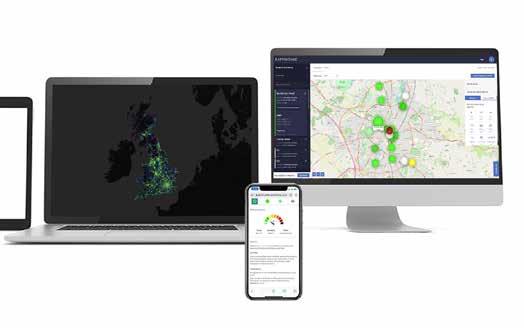
We offer air quality solutions that enable you to develop data-driven action plans. Identify high emitters, educate the public, and evaluate and report your interventions. With iMCERTS compliant measurements, a leading air quality software platform and bespoke air quality models, we offer detailed insights to empower you to work towards reducing air pollution.
www.earthsense.co.uk


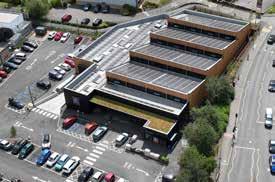


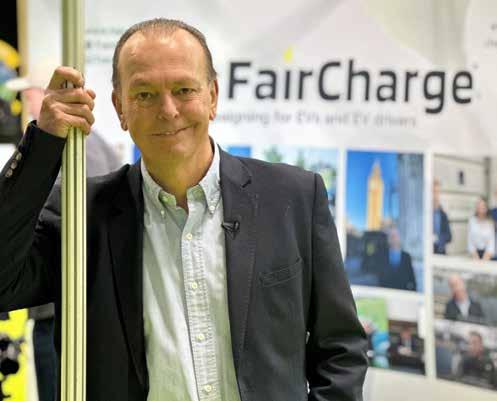

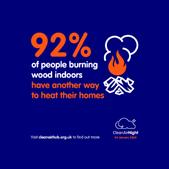

Sunderland to begin trial of selfdriving shuttle buses
Residents of Sunderland are a step closer to enjoying driverless transport following the delivery of three selfdriving Aurrigo Auto-Shuttles. The Sunderland Advanced Mobility Shuttle (SAMS) will see the buses ferrying passengers between Sunderland Interchange, Hospital, and the University Campus on public roads.
A safety driver will be on each bus but the project aims to establish and showcase a secure remote supervision protocol, paving the way for future commercial use.
The focus now will be on operator training, equipping on-board safety attendants with the necessary skills to oversee and manage autonomous operations effectively.
The shuttle will run along an intelligent transport corridor, enabled by 5G small cells which are being installed along the routes.
A total of almost £42 million has been awarded to seven projects through the Centre for Connected and Autonomous Vehicles (CCAV) Commercialising Connected and Automated Mobility (CAM) competition, with industry matching this amount. The SAMS project received from £3million from the government, matched by industry to a total £6million.
Why a car club is the cheapest route to driving an EV in London
K (CoMoUK ) have examined how much drivers would save if accessed an EV from a car club, rather than buy their own. The costs of car club use was compared with ownership and leasing for three common types of EV sold in the UK.
They found that on average, using a car club EV would save Londoners £5,573 per year compared to owning an EV that is less than three years old.
This figure rose to £6,167 per year when the use of a car club was compared to leasing, an increasingly popular option for buyers dipping their toes into the EV market.
The figures are based on data showing that on average, Londoners make 155 car trips per year as a driver, with the trip taking 24 minutes and covering 7.5 miles.
For 155 trips of this duration and distance, the annual costs for using a car club EV start at around £1,389, including insurance and fees for charging and mileage.
TV presenter and campaigner Chris Packham has been given permission to challenge the Government over its decision to abandon statutory environmental commitments.
In September the Government announced that its green targets risked bankrupting the nation and rowed back on a number of previous commitments and deadlines.
Mr Packham wrote to the Prime Minister with his concerns and, having failed to receive a satisfactory reply, filed a High Court legal challenge. He has now been given the green light to argue three points in the high court. Solicitors Leigh Day describe these as follows:
1. The duty on the Government to have policies in place to ensure it can meet its commitments under the Climate Change Act is a continuing one. He will argue that it isn’t lawful for the Government to remove key policies from the CBDP, like the ZEV Policy and the

Heat and Buildings Package, without having others in place to ensure the targets will still be met.
2. When taking the decision to abandon the policies, the Government failed to take mandatory and relevant considerations into account, including the impact of the decision on the achievement of the carbon budgets and the net zero target and advice from the Climate Change Committee (CCC).
3. There was a failure to consult the public and key stakeholders before abandoning the policies, and a failure to even consider previous consultation responses that the public and key stakeholders had made to Government questions about the policies to be abandoned.
Chris Packham said: 'The pledges which the government abandoned were important parts of the UKs plan to reach Net. Notably they were directly measurable in terms of carbon management To abandon them without having comparable quantifiable measures in place was reckless and dangerous. To abandon them without seeking qualified advice was undemocratic and arrogant.'
The High Court hearing will take place later this year.
A
team from the University of
Cambridge
has found that high levels of air
pollution can have a significant impact on the performance of teams presented with complex, collaborative, and non-routine problem solving tasks.

The team examined data from 15,000 escape room games in London and found that on high pollution days, the participants could take up to 5% longer to compete their tasks.
The Escape rooms were considered an ideal setting to study team performance because of the high level of creativity they demand. The research studied the effect of carbon monoxide, sulfur dioxide, nitrogen dioxide and PM 2.5, using data from 16 AURN
monitoring stations in London. All four pollutants were found to have a significant negative impact on team performance and, for carbon monoxide and sulfur dioxide this was seen at levels well below the current WHO Air Quality Guidelines.
Co-authors of the study include Paul Lohmann of the El-Erian Institute of Behavioural Economics and Policy at Cambridge Judge Business School who said: 'Breakthroughs in science and other fields
require teams to work together to combine knowledge and solve complex problems, so it's important to understand external factors that can affect team performance. Our findings that air pollution has a sizable and statistically significant negative effect on teams undertaking complex tasks has implications for workplaces all over the world, but particularly in emerging economies that have high air pollution levels.
'Our results have implications for all settings that require teambased non-routine analytical and interpersonal work, which characterizes large parts of the modern work environment. Many low- and middle-income economies face much higher levels of pollution, which could possibly be a drag on economic development and poverty alleviation.’
The new International Energy Agency (IEA) Emissions Report has revealed that CO2 emissions increased by 410m tonnes (1.1%) in 2023, which represents a slight improvement on last year's report which revealed a 490m tonnes increase in 2022. Total emissions for last year were 37.4 bn tonnes.
The positive news is that the increase in emissions slowed down while the demand for energy rose, demonstrating the positive impact renewables are having on global emissions. IEA have calculated that, without clean energy technologies, the global increase in CO2 emissions over the last five years would have been three times larger.
The report highlights some extenuating circumstances, without which the results would have been better yet although, as one of these is the extreme droughts which crippled hydropower around the world, we can't necessarily assume we will not encounter such conditions again.
The IEA have calculated that this hydropower shortfall was behind more than 40% of the rise in emissions, due to

countries turning to fossil fuels to plug the gap.
Had it not been for the unusually low hydropower output, the report says, global CO2 emissions from electricity generation would have declined last year, making the overall rise in energy-related emissions significantly smaller. CO2 emissions in the advanced economies saw a record fall last year, despite growing GDP. Emissions dropped to the lowest level for 50 years while coal
demand fell back to the levels of the early 1900s. At least half of electricity generation in these advanced economies came from low-emissions sources last year, the first time this has happened.
The IEA have also published the first of a new series: the Clean Energy Market Monitor, which provides timely tracking of clean energy deployment for specific technologies and outlines the implications for global energy markets more broadly.
A new study undertaken by Purdue University in Indiana has found that a gas stove can emit more nano-sized particles into the air than internal combustion engined vehicles.

These particles are extraordinarily small.
At AirQualityNews we tend to deal with PM10 and the smaller PM2.5. These measure 10 micrometers (aka 10µm) and 2.5 micrometers (aka 2.5µm) respectively.
The work at Purdue focussed on nanocluster aerosols which are between one and three nanometers. And there are 1,000 nanometers to a micrometer. To put it another way, they are 0.001–0.003 µm.
These aerosols are solid/
aqueous particles suspended in the atmosphere but not much is known about how they grow and spread indoors because they’re very difficult to measure.
As recent studies have found that children who live in homes with gas stoves are more likely to develop asthma, the Purdue team attempted to discover how much of a threat these minute particles may be.
Using state-of-the-art air quality instrumentation they were able to measure these tiny particles down to a single
Why aren't we heating our homes with wind power?
It's accepted that the decarbonisation of home heating needs to accelerate considerably and heat pumps are considered the ideal route to phasing out gas boilers but their rate of installation needs to accelerate.
Campaign group Possible and energy experts Regen have looked at how heat pump adoption could be accelerated at a community level, finding that wind power would be an ideal match for heat pumps because it’s windier in the colder months.
Regen found that wind power could power two-thirds of the energy needed to run heat pumps. If solar and storage are added in, the savings would be up to nearly a third off energy bills.
Furthermore 3,700 of the most deprived neighbourhoods in England, are within 1km of an area with good onshore wind resources.
Possible are now calling on the government to reform the electricity market so that bill payers can benefit from the lower costs of renewable energy, remove the planning barriers for new onshore wind, particularly for community projects and provide access to grant funding and low-cost finance for community energy and heat projects.
New SUV sales increase by 23% in one year
nanometer while cooking on a gas stove in a 'tiny house' lab. They collaborated with Gerhard Steiner, a senior scientist and product manager for nano measurement at Grimm Aerosol.
The house has all the features of a typical home but is equipped with sensors for closely monitoring the impact of everyday activities on a home’s air quality. In this testing environment the team collected extensive data on indoor nanocluster aerosol particles during realistic cooking experiments.
They found that as many as 10 quadrillion nanocluster aerosol particles could be emitted per kilogram of cooking fuel. Comparing these findings with known outdoor air pollution levels, which are more regulated and understood than indoor air pollution, they found these emissions were equal to, or even greater than, those produced from ICE vehicles.
New research from Transport & Environment has revealed SUV sales broke the one million mark for the first time last year. A 23% increase from 2022. T&E speculate that by 2027 SUVs could make up 75% of new registrations. While car manufacturers have been criticised for including a disproportionate number of SUVs in their electric vehicle output, 83% of those sold last year were petrol and diesel cars, hybrids, or plug-in hybrids.
Ralph Palmer, from T&E said: 'SUV sales in the UK growing by more than a third in just two years is a dangerous trend. The stubbornly high levels of polluting SUV sales is not only negating emissions savings from the move to battery electric vehicles, it’s embedding a culture of large, luxury cars, which is simply unsustainable.'
Sarah Rowe for the Clean Cities Campaign in Manchester, said: 'I’m worried this trend for bigger cars means we’ll simply run out of space for things we actually need; green space to relax in, safer spaces to walk and cycle and public space for communities to thrive.’













A hyperlocal view of air pollution for targeted interventions
















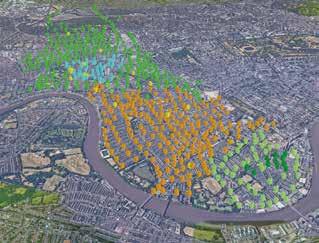



Make the invisible, visible.
Measure. Monitor. Act. We make reducing air pollution simple.
Automated 24/7 monitoring


‘Always up’ self-healing wireless mesh network
Web based UI dashboards with analytics
Fit & forget - no site visits
Lifetime warranty




Priced for scalable & high density deployments
Sensing-as-a-Service
SIM card free
Start Monitoring today
www.vortexiot.com
“
Supported by the Welsh Government, Vortex joins one of six suppliers in the Well-Being Wales programme.
In a landmark partnership with the Welsh Government Commercial Delivery (WGCD), Lyreco has launched a new programme focussing on well-being and environmental initiatives to deliver social value benefits to the Welsh public sector organisations and the local communities they serve.
As one of six Welsh suppliers, Vortex proudly announces its partnership with Lyreco as a key reseller under the new Cymru Clean Air Scheme.
This partnership is the latest in a host of sustainability initiatives we have worked on with our strategic supplier, Lyreco. This new collaboration will simplify access to our award-winning air quality monitors by the Welsh public sector.”
Nick Ruxton-Boyle Director of EnvironmentThe Cymru Clean Air scheme empowers Vortex to collaborate with Lyreco and the Welsh Government to centralise and prioritise clean air initiatives across local authorities in Wales. At the forefront of this effort is initiating hyperlocal air quality monitoring.
Hyperlocal monitoring is the benchmark for effective pollution reduction projects, aiming to identify pollution hotspots and validate controlled interventions by harnessing real-time data on air pollutants and greenhouse gases. With an end goal of fostering cleaner air, particularly around critical areas such as schools and healthcare units, these initiatives significantly impact the health and well-being of the people of Wales.
“
Supporting environmental, and well-being initiatives is at the heart of everything Lyreco strives towards and stands for. The Cymru Clean Air Scheme, a newly established well-being partnership between Neath-based Manufacturer (of hyperlocal air quality monitors) Vortex Ltd and Lyreco UK & Ireland, is a shining example.”
Diane Brooks Frameworks Manager - Public Sector WalesDiane continues to say: ‘Via Lyreco’s single source framework agreement and our long-standing commitment to collaborative working, Lyreco and Welsh Government Commercial Delivery (WGCD), and guided by the key pillars of the Well-being of Future Generations Act (Wales), we’re facilitating change and a positive impact that continues to deliver tangible social value benefits, to both the Welsh public sector organisations and local communities we service, and they in-turn serve. Through the scheme, stakeholders will soon be able to accurately monitor their local air quality and act where it counts. By working together, Wales can breathe a better tomorrow.”
This joint endeavour between Vortex, Lyreco, and the Welsh Government signifies a groundbreaking stride toward a sustainable, healthier Wales. Through concentrated efforts and a shared vision, this partnership aims to set new standards in environmental stewardship while nurturing a thriving business landscape.
“
We look forward to working across the country supporting pollution reduction and climate resilience projects and monitoring.”
Nick Ruxton-Boyle Director of EnvironmentThe official launch of the Cymru Clean Air Scheme was held at the ICC Wales Centre, Newport, for the inaugural Cymru Clean Air Conference on Thursday, 8 February. The event focused on bringing Wales’s local authorities together to discuss air quality management plans and how to drive real environmental change through innovation and partnership.

As soon as February kicks in, many Thais anticipate the return of the dreaded haze that chokes Northern Thailand and some parts of the Lower Mekong region for many months, affecting millions of people who have been forced to endure toxic haze pollution for decades.
Thailand’s haze problem is the result of government-backed industrial-scale cultivation of maize by big corporations for animal feed. It’s a policy that solely benefits the meat industry to expand its business and influence, with little accountability, in the sub-Mekong region.
With an El Niño forecast, one can only imagine what the 2024 haze outlook will be for the rest of Southeast Asia which experiences alarming air pollution primarily due to forest fires.
Indonesia and Malaysia are notorious for clearing their peatlands for palm oil cultivation. Land clearing for plantations causes peatlands to become dry and vulnerable to fires. With deforestation and drainage, the water table is lowered, preventing further carbon intake. Once exposed to the air, peat starts to decompose. With dried-out peat comes the risk of forest fires, which creates more haze. Haze pollution has resulted in a pattern of extensive social, environmental, and economic harm. Unfortunately, countries belonging to the Association of Southeast Asian Nations (ASEAN) - the region’s governing economic and trade bloc - have not stepped up efforts to combat transboundary haze.
There is growing evidence of mortality effects related to long-term exposure to ambient air pollution, which is currently the greatest external threat to human life expectancy on the planet, comparable to the effects of smoking and more harmful than alcohol use, unsafe water, and transport injuries combined. Breathing haze with an Air Pollutant Index (API) of 500 is equivalent to smoking around 23 cigarettes a day on a regular basis. Transboundary haze has been a part of life for many in
Southeast Asia. Some have grown accustomed to it without being aware of the dangers it poses. But most remember the 2015 episode, when the haze engulfed much of the region, causing schools and businesses to temporarily close and even disrupting flights.
It was only recently known how exposure to smoke from the 2015 forest fires resulted in 100,300 premature deaths in the region. Despite an ASEAN Agreement on Transboundary Haze Pollution (AATHP) being signed in 2002, the 10 member states collectively failed to address the air pollution crisis that again hit the region in 2019. Even with two record-breaking haze incidents, ASEAN continued with their usual ‘diplomacy’ of non-interference.
The Singapore government estimated losses of between $500 million and $1.34 billion from the 2015 haze. For the 2019 haze, the World Bank estimated $5.2 billion in losses for Indonesia, while researchers in Thailand estimated $77 million in losses for Bangkok alone. Despite these economic impacts, no drastic measures were taken.
ASEAN also needs to consider the unknown effects and unforeseen harms that haze pollution will continue to inflict on people in the region in the context of COVID-19. The pandemic has massively depleted governments’ resources and will continue to place immense pressure on healthcare systems in the foreseeable future. A 2021 study has identified links between emissions from forest and peatland fires (PM2.5, carbon monoxide, and ozone) with increases in COVID-19 infections and deaths.
There’s a company behind every great smog
With the constant threat of transboundary haze, it’s time we pin down who causes it.
According to Indonesia’s Environment and Forestry Ministry, the 2019 forest fires burned 857,756 hectares of peat and mineral soil between January and September, an area that is

almost 12 times the size of Singapore. According to Greenpeace Indonesia’s research, a group of Singaporean and Malaysian companies actually own some of the palm oil and pulp and paper plantations that were burned and cleared, contributing to the regional haze. These companies, despite clear violations, have not been sanctioned. The data used in the research was compiled from a variety of public sources by Greenpeace because no data has been made available by the Indonesian government.
Thailand’s Greater Mekong Sub-Region shares a similar story where the fire culprits are even much harder to pin down. Agricultural land in the Mekong Sub-Region is significantly devoted to industrial-scale mono-cropping. With the increasing demand for maize to process into animal feed in the region, maize production has come under the spotlight for causing deforestation due to the burning of land for pre- and postharvest, ultimately contributing to regional air pollution. Maize cultivation for animal feed was responsible for almost half of the transboundary haze in 2023.
While industrial maize production is largely blamed here, the information about agribusinesses occupying the land is often lacking. Without this information, the Thai government cannot hold corporations accountable for the health and environmental impacts of the haze in their supply chains across the region.
Fed up with repeated government inaction and lack of corporate accountability, ASEAN citizens are now taking matters into their own hands and suing their governments for failing to protect and uphold people’s basic rights to clean air.
Noting how the AATHP continues to be unenforced and lacking in corporate accountability, in 2021, Malaysian civil society filed a pioneering complaint at the Malaysian Human Rights Commission (SUHAKAM) as a proactive countermeasure to address the chronic and persistent haze
pollution. The group hopes to empower haze-impacted individuals and communities not only through greater public access to information on the source of haze, but also its effects on their livelihood and the companies who are responsible. The complaint also recommends the strengthening of domestic environmental laws and regulations, as well as strengthening human rights practices within businesses based on the United Nations framework.
In 2022, residents in Northern Thailand filed a lawsuit against the Thai Prime Minister and the National Environment Board (NEB) for failing to step up action on the PM2.5 crisis which got so severe that, in early 2023, Chiang Mai was ranked the World’s Most Polluted City with thousands admitted to local hospitals with severe respiratory problems. Last month, the Chiang Mai Administrative Court released its verdict and instructed the defendants to enforce the law immediately to develop and introduce inclusive emergency measures to address Northern Thailand’s haze pollution within 90 days.
As Southeast Asia gets back on its feet after COVID-19, it is hoped that ASEAN governments heed their citizen’s plea and work together to eliminate transboundary haze pollution in the region. Accountability is the key area that respective governments should focus on.
Greenpeace Southeast Asia recommends that ASEAN states enact their own domestic Transboundary Haze Pollution Act. The Act was the first concrete step following the ASEAN Agreement on Transboundary Haze Pollution in 2002.
Having their own Transboundary Haze Act can provide legal grounds to institutionalise checks and balances, to ensure that a local company is not contributing to haze locally and abroad.

Greenpeace Southeast Asia demands ASEAN states to:
❶ Develop a regional legal framework to hold corporate entities accountable for domestic forest fires due to peatland clearance and agricultural residue burning.
❷ Mandate all companies known for clearing out forests to publicly disclose and publish concession maps to be shared across all ASEAN member states to improve transparency in their supply chains.
❸ Agree on a standardized air quality indicator to be used in all ASEAN member states to monitor and track air pollution based on a common methodology and act accordingly.
Forest fires and haze pollution are man-made disasters that could have been prevented by governments in the region and many lives could have been spared. Big companies that are responsible for fanning the flames continue to make huge profits at people’s expense. It’s time to address the huge elephant in the room and end the injustice.

Dr James Heydon is an Assistant Professor in the School of Sociology and Social Policy at the University of Nottingham. His research centres on how formal and informal social controls can be used to address environmental problems.
Exposure to fine particulate matter (PM2.5) emissions can cause serious health problems for vulnerable groups, such as the young, elderly and those with preexisting conditions. In the decade since 2012, PM2.5 emissions from domestic combustion – households burning fuels like wood, coal and smokeless fuels to heat their home – increased by 19%.
By 2022 this made up almost 30% of the UK’s PM2.5 emissions.
Given this increase, one could be forgiven for thinking that UK policy makers are blind to the problem or have little interest in legislating against it. However, this couldn’t be further from the truth. The UK has one of the oldest regimes for controlling domestic combustion emissions anywhere in the world.
So, what is going on?
The UK’s main regulatory tool for tackling domestic combustion emissions is the smoke control area (SCA).

Originally created by the Clean Air Act 1956, these SCAs create zones where use of highly polluting fuels (like coal) and appliances are prohibited. If someone is found to be breaking these rules, by emitting visible smoke from an appliance or fuel not on a government list, they can be fined. However, at almost seven decades old, this regime is outdated and has several features that make it unfit for purpose in the present day.
Created in the 1950s to control the
smoke-fuelled London smogs that killed 12,000 people in three months, these regulations have evolved very little over the intervening period. SCAs cover less than 10% of the UK’s landmass and are fragmented across local council jurisdictions, creating an inconsistent patchwork of rulebound space both within and between urban areas.
While some SCAs cover whole population centres (e.g. Manchester and Birmingham), others apply to only a small number of roads or neighbourhoods within cities populated by hundreds of thousands (e.g. Cambridge and Norwich). Other cities have no SCAs at all, like Cardiff, with a population of over 360,000. This is similar to most rural locations, where whole towns and villages – which have changed significantly since the 1950s – have no SCAs at all (e.g. Loughborough and Stafford).
Even where they do exist, SCAs are difficult for councils to enforce. Between
2014 and 2020, only 0.04% complaints against chimney smoke resulted in a fine. Even after the Environment Act 2021 made it easier for councils to issue penalties, only one fine resulted from the 10,000 complaints received since January 2022. This points to the limits of a complaints-driven approach reliant on public knowledge of an obscure problem, and the difficulties investigating complaints once reported. Put simply, it’s not easy to evidence chimney smoke out of hours, among any number of smoking chimneys and condensing boilers, in winter, in the dark.
This reality is set against the backdrop of resourcing constraints. Between 2010 and 2020, the amount of money councils received from central government fell by 40%. Since then, the pandemic and rising cost of living have further squeezed resources, causing several councils to declare ‘bankruptcy’. It is little wonder the default council complaint response is to send a letter containing central government advice on how to ‘burn better’.
This points to another problem. Even if SCAs covered the entire country, and enforcement was easy, an abundance of PM 2.5 would still be emitted. Stove regulations are caught in tension between what they were introduced to achieve and what is now expected of them. In the 1950s, SCAs discouraged the burning of coal in fireplaces by encouraging use of relatively ‘smoke-less’ fuels and stoves instead. This made sense when smoke was the issue. However, since then, the much less visible PM 2.5 has come to be recognised as a distinct (though related) problem.
Even when no smoke can be seen, the latest stove appliances - operating under ideal conditions - emit over 300 times the PM 2.5 of a gas fired boiler each hour, and produce 750 times the PM 2.5 of a new heavy goods vehicle. They also emit twice the amount of ultrafine particulate matter as older designs, which is smaller and more toxic than PM 2.5
This is problematic when considering that Defra has exempt over 2,500 types of stove from SCA rules since 2010 - these can be installed and lit anywhere, in any number, and for any length of time. Ultimately, in relying on seventy-year-old regulations to persuade people to ‘burn better’, SCAs are encouraging a practice that still produces ample amounts of PM 2.5 .
What, then, is to be done?
A dominant reason for stove use is the ‘cosy aesthetic’, being installed and lit by those who already have central
heating. With the smogs of the 1950s a distant memory, ‘Defra-certified’ and ‘Ecodesign’ labels popularising the notion that wood burning is ‘environmentally friendly’, and stove use becoming more fashionable among the affluent, burning solid fuel to heat the home is now generally seen as harmless and desirable.
In this context, several campaign groups have called for stoves to be phased out where no other heating source exists. Aimed at ‘denormalising’ this ordinary yet collectively harmful behaviour, there are several points at which such efforts can be directed.
At the point of sale, health warnings to raise awareness of stove emissions (both indoor and outdoor) is an option, having been called for by researchers and more than 100 MPs. Restrictions can be placed on marketing, similar to e-cigarettes, that undermines public health messaging. A full advertising ban could also be considered, much like tobacco products.
to counter prevailing understandings of domestic burning as harmless and, much like driving under the influence or while using a mobile phone, discourage behaviour. Lancaster and Camden councils, and Surrey Air Alliance, operating in support of Global Action Plan’s Clean Air Night, are examples of messaging campaigns employed to raise awareness of the public health effects, counter industry narratives, and dissuade use.
One innovation being trialled by a team at the Universities of Nottingham and Sheffield is the UK’s first ‘burn alert’ tool, which introduces the possibility of ‘no burn days’. Existing warning services tend to advise people on how to avoid air pollution (e.g. “reduce physical exertion…outdoors”), but burn alerts ask stove users not to light if air quality is already - or projected to be - poor. In this way, the tool speaks directly to the source of PM 2.5 instead of those exposed to it.
Spikes in living costs can encourage

At the point of installation, air quality limits could be introduced that restrict the installation of solid fuel appliances in homes, as in London. More direct restrictions could also be pursued, such as no new installations within SCA boundaries, urban areas or in new builds (e.g. San Francisco).
Even if the number of stoves purchased and installed is capped, this still leaves millions in operation. Targeted information campaigns can be used
people to burn scavenged or waste wood to save on heating bills. For these, financial support needs to be coupled with longer-term efforts at improving insulation and encouraging wider uptake of cleaner domestic heating technologies.
Ultimately, though, without SCA reform a wider suite of interventions is needed to compensate for the deficiencies stemming from continued reliance on a 20th century regime to address a 21st century problem.





Heat networks aren’t new.
Rather than installing an individual gas boiler in every apartment in a block of flats, or in every premises in a commercial development, hot water is supplied to all units from a single source. But now, as part of wider efforts to decarbonise, we’re seeing highly efficient heat networks installed on much larger scales, to whole communities, actively encouraged by government.
‘Heat networks are set to play an increasingly vital role in the UK,’ says Luca Grella, Innovation Programme Delivery Manager at UK Power Networks. ‘According to the Climate Change Committee, they’re projected to contribute around 18% of UK heat by 2050, a significant rise from the current 2%.’ Luca is part of the team involved in Heatropolis, a heat network being developed in the Kings Cross area of London, which will provide heat and power to premises including Google and Nike’s UK HQs, and 2,400 homes.
The hope is to use the Heatropolis initiative to better understand the options so that similar projects across the country can more efficiently decarbonise while delivering reliable heating and power.
The government is keen to support such projects that reduce energy bills
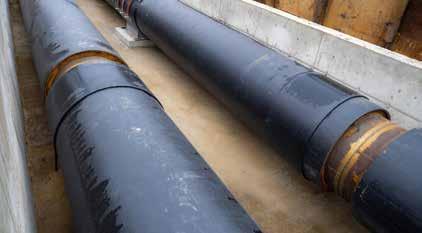
for consumers — and will only support projects that don’t cost consumers more than alternative options. To qualify for support from regulator Ofgem’s strategic innovation fund (SIF) the Heatropolis project had to demonstrate that it ‘delivers benefits for customers and for the environment,’ as well as addressing the regulator’s key strategic challenges. Ofgem was also keen to see ‘collaboration between utilities, technology developers, academia, local authorities and other key stakeholders in the energy industry.’ Having met those conditions, SIF support was duly awarded to the Heatropolis project in April 2023.
Since then, Luca says the team are in regular contact with both Ofgem and UK Research and Innovation (UKRI) to ‘track progress, adhere to specific project conditions, ensure widespread dissemination and sharing of learnings across our industry and to consumers.’
Most important of all, says Luca, is the ‘focus on delivering innovative value.’
For both the SIF and the UK Power Networks team, a core principle is ‘to facilitate a “just transition” to achieve net zero at the lowest cost for customers.’
Luca explains that part of the issue is being ready for changing demands. At the moment, ‘heat networks mainly
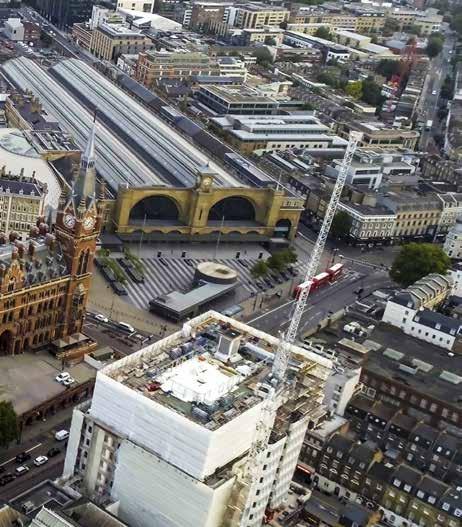
rely on fossil fuels,’ says Luca. ‘But as the country moves closer to net zero targets there will be a transition towards electrification and a greater demand for electricity to power the heat networks, alongside other decarbonisation efforts such as encouraging the adoption of electric vehicles.’
That means care must to be taken to protect local electricity networks. ‘Excessive demand would necessitate upgrades to our infrastructure and we want to avoid reinforcement costs which would be an element of customers’ bills. We want to make sure our idea is giving the best value to the customer, as well as delivering impact to the right industry problem.’ To do this, ‘We’re engaging experts encompassing areas like flexibility, connections and network planning to ensure our endeavours are grounded in substantial data and industry standards. Our project partner Passiv has provided project management, smart control testing, a commercial and operational framework, dissemination and beta planning. Additionally, subcontracted specialists are enlisted to support various activities. Metropolitan serves as the heat network operator, providing site and technical designs.’
This is a large scale, ambitious project in a prominent location in the heart of London, where big name brands are headquartered. What involvement do the likes of Google and Nike have in the
project? ‘The entire Kings Cross estate is involved in this initiative to enhance building and network efficiency,’ says Luca. ‘The level of engagement has been outstanding.’ The team provides regular updates to all stakeholders through the estate's sustainability forum.
‘So far, we’ve outlined the overarching decarbonisation roadmap and the necessary actions building owners and operators must take to contribute.’
Local residents and businesses stand to save money on bills, and the Heatropolis project supports government aims to decarbonise. The local electricity network is protected without the need for costly enhancements to the infrastructure. But that’s not all. ‘Additional benefits include improved planning and forecasting capabilities,’ says Luca, ‘providing valuable data to support the potential mitigation of reinforcement, and a better understanding of market flexibility to manage supply and demand effectively. It would also enable us to offer the best flexibility options to customers through our distribution system operator’s flexibility teams – not to mention other benefits to the wider energy system.’
It all sounds very positive, so how far along is the project at this moment?
‘We’re currently in the “Alpha” phase of the second round of the Strategic Innovation Fund (SIF) Round 2,’ says Luca. ‘This stage focuses on building on findings made during the discovery
phase by validating assumptions, testing technical requirements and refining the commercial mechanisms necessary to implement our Heatropolis framework.’
‘Our collaboration with operator Metropolitan is progressing well. We are actively working on key deliverables, including selecting a testing site for our smart controls, understanding the available data feeds for testing assumptions, refining the cost-benefit analysis and engaging with partners. We're also working with subject matter experts across UK Power Networks’ teams to evaluate options agreed on by heat network operators.’
‘The modelling will start once we have collected sufficient input from our subject matter experts. The actual trial will be conducted during the “Beta” phase, planned to start at the end of 2024 providing our application is successful.’
But even at this early stage, Luca says they've already learned a great deal. ‘Our initial findings demonstrate that heat networks can play a significant role in fostering a more adaptable, low-carbon energy system, ultimately leading to cost reductions,’ he says. The team are now focused on ‘assessing this flexibility and determining the optimal approach to maximise overall system value.’ They’re also, ‘working on establishing a clear framework for heat network operators and electricity network operators to collaborate on connection arrangements that incentivise investment in resilient and reliable electrical networks.’ The hope is that, ‘this framework will facilitate greater decarbonisation of heat supply to buildings through efficient heat networks, delivering benefits for both consumers and the environment.’
Many heat networks are already powered by green energy. Air-source and ground-source heat pumps are commonly used to produce the heat that is then distributed to homes and businesses connected to the system. But innovative alternatives include:
• Langarth District Heat Network in Cornwall, where a borehole drilled 5,275m into the ground will access geothermal energy to heat some 3,800 homes.
• Torry Heat Network in Aberdeen will recycle energy produced by the new East Tullos plant disposing of otherwise non-recyclable waste from local councils.
• Bolton District Heating Network will use a heat pump to extract waste heat from the town’s combined sewer.

It’s an early-February evening and Skellefteå is bathed in the glow of streetlights and pure white snow.
Life here feels frozen in a moment, which at -15C on arrival, is completely understandable.
But appearances deceive, and this corner of the subarctic moves fast. As the region’s Market and Business Development Manager, Bo Wilkstrom tells us, specialised industries are fuelling rapid population growth, and turning this small town into Sweden’s net zero transition testbed. Authorities now have a big ambition to ‘become global frontrunner, take risks, and build a new society’ around principles of renewability and sustainability. Some people even come as tourists because they ‘want to see, want to know’ about the latest climate tech, transport, and energy developments.
Most visitors will arrive through the carbon neutral airport, which is also home to one of the world’s only electric aviation schools, using planes it is hoped will one day be the go-to modality for short distance commutes. Many take buses that run on entirely organic waste. All will use 100% renewable electricity for the duration of
their time here, and the lucky ones might stay at Wood Hotel by Elite.
The second tallest timber-framed tower on the planet, this 20-storey prefabricated skyscraper also houses Sara Kulturhus, an arts venue with six stages, the largest seating 1,700 people, and a ground floor foyer doubling up as indoor public realm, serving everything from Sunday morning yoga to pre-theatre drinks, safely protected from the perishing conditions outside. Skellefteå’s municipal library is here, too.
Lumber had a huge impact on the footprint of this address. Considered among the most advanced timber buildings ever created, it absorbs more carbon dioxide (CO2) that it emits, even when all 205 rooms are occupied. In total, 12,000 m3 of wood was used, sourced from within 60km of the hotel. Forests that supplied other projects in town, like the historic Lejonströmsbron wooden bridge, dated 1737, and a modern three-storey car park made of plywood.
In Sweden, 70% of land is forest, and the timber industry is well managed and environmentally controlled. Producing 18million m3 of lumber each year, even with 13million bound for export there’s
enough to produce 90% of all lowrise builds in the country. And larger scale developments are also becoming increasingly visible, like Stockholm’s aptly named Wood City.
Once complete, this timber town will span 60 acres, and provide 2,000 houses and 7,000 business units. A grand masterplan developed because real estate and asset management giant Atrium Ljungberg AB needed to begin working on climate-friendly projects to meet its own targets, and understood the benefits wood offers, from emissions savings, carbon capture and storage, to air pollution mitigation, and speed of completion.
‘There are timber buildings in London, but most have traditional steel frame and concrete core,’ Charlie Green, co-founder of The Office Group, says of the Black & White Building in an interview with Financial Times. The British capital’s tallest commercial address made from engineered timber, it has 37% less embodied carbon than it would, had denser materials, more commonly used in UK construction, been used.
Savings come from several aspects specific to structural wood. Timber is less

energy-intensive to produce than concrete, and as lumber is far lighter it means shorter build times – on average 25% faster than heavier structures. As such, there are fewer journeys needed to transport the workforce and materials, less days when direct on-site emissions are produced, while particulate matter falls because there is no concrete being cut.
‘I was at a conference last week on constructing excellence in London, and completely unsolicited one of the speakers said to me: ‘the bottom line is we’ve got to use less concrete, less steel, and more timber’. That would have been my message, but for an independent procurement expert to talk like that, I think the penny has dropped in terms of benefits from timber construction,’ says Andrew Carpenter, Chief Executive of the UK Structural Timber Association. A man who clearly wants to see more wood in UK building stock, support from outside has rarely been higher.
In December, the UK Government published its Timber in construction roadmap, which aims to level up huge regional differences in the prevalence of timber buildings. In England, just 9% of
new build homes have a wooden frame, go to Scotland and it’s 92%. The new plan will also help deliver on a legally binding target of 16.8% forest cover in England by 2050, helping support habitat recovery and reverse the country’s shocking biodiversity crisis.
Several steps are critical to meeting the objectives. These include improving data on timber and whole life carbon to ascertain more details on true benefits, promoting and improving access to sustainable and
looking at timber. So, there is desire from the Department of Education to use timber in its school-building programme. The health sector is looking at timber for hospitals, we’re really beginning to see a lot of areas start to consider this frame as an option.’
Other parts of the economy – such as hotels and student accommodation providers – have longer histories with timber, although it’s only relatively recently the material fell out of favour with English

safe products, including ‘free from’ timbers which overcome indoor air pollution issues linked to certain glues and solvents, facilitating closer collaboration between stakeholders, and innovating new high performance construction systems.
‘After COP26 in Glasgow, the UK Government, headed by DEFRA, set up a working group to increase the amount of timber in construction because they recognise that if the UK is to meet its net zero target, construction materials must be a priority,’ explains Carpenter, who is now secretariat to the roadmap process, representing the timber industry. ‘Now there is a clear route, and we’re only a month or two in but the commitment Government is showing is first class.
‘I’ve put together the planned process to manage implementation and they seem to be behind that, so it’s early doors but the signs are good,’ he continues. ‘Other sectors [outside housebuilding] are also
developers, and buyers. A 2018 report in UK Construction Online suggests the market was growing pre-pandemic, but still hadn’t recovered from a huge crash in the 1980s driven by negative reports about quality and safety. The timber construction sector plummeted from 40% of new build market share to less than 10% in a single year, only reaching 28% again in the last decade or so. Faith is gradually being restored through hard evidence.
‘The first question that is often asked of us is around fire safety,’ Carpenter replies when we quiz him on concerns people might have with using structural timber. ‘We have significant results, for both timber frame and more recently CLT [crosslaminated timber], which show if a building is designed properly and built properly, in accordance with best practice, there's no reason there should be any more fire risk than with other materials.
‘Cost is probably the second objection.


But an independent test carried out by a quantity surveyor, RLB, looking at social housing developments, found timber frames were actually 1% cheaper than alternatives, and 19% faster to finish. Similar research has found it to be 2% cheaper, but the reality is, on price, materials are almost like-for-like,’ he continues, before revealing this data is now being expanded. ‘As part of the new roadmap the Government has asked us to do a more comprehensive cost comparison, broadening the scope beyond social housing alone, so that should be interesting to see the results.’
In a world without silver bullets, Carpenter is clear that timber alone will not solve the quandary of how to continue making new buildings while protecting the planet and our atmosphere. So while ‘an ideal world’ for him might involve completely substituting concrete and steel, he says this is unlikely to prove practical. Instead, it’s as much about bringing more wood into the mix as it is pushing a ‘timber first policy’. Simply put, ‘you must choose materials appropriate for the given solution’.
‘We know there are going to be several barriers along the way, challenges that will need to be overcome. We’ve broken this down into seven working groups dealing with supply, demand, carbon, building safety, insurance, skills, and innovation. For the last two years we’ve had working groups looking at each of these, and that fed directly into the roadmap,’ Carpenter continues. ‘We've had industry experts involved every step of the way; you know?
‘From RIBA to the HSE, Home Builders Federation, the timber sector, wider industry, and so on. Nothing has been done in isolation. It's been done
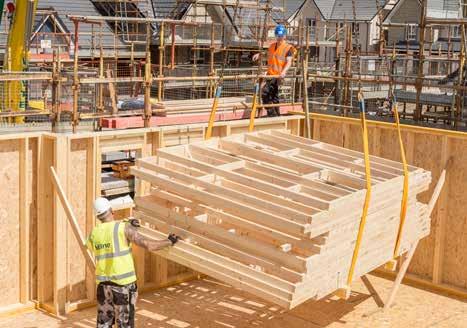
with government departments, trade, but also the wider sectors,’ he adds. ‘So, I don't think we've missed anything. The important thing now is we have a number of recommendations, some for government, some for industry, some for both. For me, it's a question of ticking them off one by one and agreeing a plan for each to implement their steps.’
Of course, the outcome of the roadmap will only become apparent over the course of several years, but Downing Street clearly needs this program to deliver for many reasons. Not least tackling the 25% of total national greenhouse gas emissions that come from Britain’s built environment, bolstering efforts to increase tree cover in a country that’s among the world’s most biodiversity-depleted, and increasing the supply of new housing stock to help mitigate what now feels like a crisis in perpetuity.
It all seems like a win-win, but to be truly effective implementation must be focused on long term outcomes. Like growing a sustainable domestic industry, taking full advantage of the predicted rise in demand driven by this new Government initiative. And investing in improving and expanding the available workforce, with staff shortages currently the biggest nonclimate challenge facing construction as a whole.
Perhaps most importantly, though, this roadmap must be met by a willingness to stay committed on all sides of the political sphere, or we risk taking two steps forward, and one step back, repeating the vicious cycle of false starts and abandoned ideas which has plagued environmental policy in the UK and globally. The outcome of which has been precious time wasted, squandered opportunities, and financial black holes. Patterns we can ill-afford to repeat.

Bridgewater Hall in Manchester

Dr. Karen Barrass
Roy Harrison is Queen Elizabeth II Birmingham Centenary Professor of Environmental Health at the University of Birmingham. His research interests are in air pollution, especially airborne particulate matter. Recent research has focussed on Beijing, Delhi and the UK. He has also been heavily engaged at the science/policy interface as a past member of Defra’s Science Advisory Council, and a current member of their Air Quality Expert Group and the DHSC Committee on the Medical Effects of Air Pollutants. He was a contributor to the WHO Global Air Quality Guidelines (2005) and the Guidelines for Quality of Indoor Air (2010). He was awarded an OBE in 2004 and elected a Fellow of the Royal Society in 2017.
Karen founded Climate Insights in 2023 to provide bespoke indepth research and policy analysis on today’s urgent environmental challenges. She previously led policy and research activities at UK100, where amongst other activities she developed the Clean Air Net Zero programme of work. Prior to this, she spent four years advising European parliamentarians on climate, air quality and transport and working with communities across the South East. She has a long track record as an independent consultant, working with various international public and private organisations on transport and sustainability, including Urban Foresight, Global Action Plan and UN Habitat.


Sarah Rowe is the Greater Manchester campaigner for Clean Cities. She has over 10 years experience in engaging people in issues of social justice and is now working alongside local partners in Greater Manchester to campaign for positive solutions to toxic air. She dreams of a world where getting around by bike, with a toddler, does not feel like a daunting experience. The Clean Cities Campaign is a European network delivering campaigns and research to urge cities to phase out petrol and diesel vehicles by 2030, and prioritise active, shared and electric mobility.
Alice is a Research Associate at Imperial College London. She is working on the SAMHE project which is conducting large-scale air quality monitoring in UK schools to better understand schools’ indoor air quality. The project encourages engagement from pupils with their school environment as citizen scientists. Alice is analysing the data collected from the network of monitors and helping to coordinate the SAMHE Champions Initiative which engages key stakeholders who work with schools to promote and champion the SAMHE project. Alice conducted her MEng and PhD at the University of Cambridge. Her PhD research focussed on the dispersion of pollutants indoors and use or air cleaners to improve indoor air quality.


Joining Alice will be Dr Rhys Archer. In addition to the SAMHE project, Rhys works on the Youth LIVES project – which co-produces mental health research with young people – and leads a campaign called Women of Science, which she founded in 2016.
Rhys holds a BSc in Textile Science and Technology & completed a PhD in Materials Engineering at the University of Manchester. She also has expertise in leading outreach and public engagement, and as a result was awarded the Robert Perrin Medal in 2020 for outreach activity in Materials Science and Technology targeted at 11-19 students from the Institute of Materials, Minerals, and Mining.

Amber Titchener is the dedicated Air Quality Officer at Southampton City Council. Having worked on the award-winning air quality project partnered with the Environment Centre and air quality specialist, EarthSense. Delivering an innovative air quality project to monitor and tackle particulate matter emissions from wood burning in four local authorities in Hampshire. Amber also project manages the Clean Air for Schools initiative, focused on increasing children's awareness of air quality while minimising their exposure to pollution. She is also involved with the new Healthcare Air Quality Engagement project, partnered with Global Action Plan and the Environment Centre to train healthcare professionals to be able to educate vulnerable patients on air pollution information and how to minimise the impacts of pollution. Amber works closely with the MyJourney travel awareness campaign that aims to help Hampshire residents get around more easily and actively. She is passionate about protecting our environment and fostering healthier lives for future generations.
Pablo Garcia, Senior Air Quality Modeller at EarthSense, leads technical planning and advancements in the pollutant transport core of the MappAir model. An experienced Chemical Engineer with a PhD from Carnegie Mellon University, his expertise lies in the mathematical modelling of chemical processes, particularly in atmospheric chemistry, emissions, and air quality. Pablo's research focuses on high-resolution air quality modelling in urban areas, contributing to evidence-based policy design, exposure assessment, and air quality forecasting. With a rich academic background and industry experience, he brings a wealth of knowledge to developing insights into air quality data.

09:40 – 09:55
09:55 – 10:35
10:35 – 11:15
11:15 – 1150

Andrew Whittles is the Director of Air Quality Programmes at Bradford Council. His role includes developing and implementing a Clean Air Plan, CAZ and wider projects including HyBradford, Climate Change and Sustainability Programmes
In 2004, Andrew designed the first Low Emission Zone in the UK, on the Greenwich Peninsula in the Royal Borough of Greenwich. He also designed the Low Emission controls for the London 2012 Olympic Park, as well as developing strategies for Slough, West Midlands. West Yorkshire, Liverpool City Region, Southampton and Northampton local authorities. During five years at Cenex, the UK’s first Centre for Excellence in Low Carbon and Fuel Cell Technologies, Andrew developed the DEFRA-funded Low Emission Strategies Programme and he also spent three years working with Richard Branson’s Carbon War Room in Washington.
Opening remarks from Paul Day, Editor of AQN, and our host, Beverley Nielsen
Andrew Whittles, Director of Air Quality Programmes, Bradford Council
Alice Handy and Dr. Rhys Archer, SAHME project
MORNING REFRESHMENTS BREAK
11:50 – 12:35 Panel discussion
12:35 – 13:30 LUNCH
13:35 – 14:15
14:15 – 14:55
14:55 TO 15:25
15:25 – 16:10
16:10 – 16:50
Amber Titchener, Southampton City Council and Pablo Garcia , EarthSense
Roy M Harrison OBE, Queen Elizabeth II Birmingham Centenary Professor of Environmental Health, University of Birmingham
AFTERNOON REFRESHMENTS
Sarah Rowe, Greater Manchester campaigner, Clean Cities
Dr. Karen Barrass, founded Climate Insights, which provides bespoke in-depth research and policy analysis on today’s urgent environmental challenges.







Turnkey’s new iPM instrument employs a unique combination of light extinction and light scatter to accurately analyse individual airborne particles. This allows the instrument to simultaneously measure all the PM size fractions with great accuracy.
Unlike fan-based samplers, iPM has a proper pump, air filter, and accurate flow controller to generate a stable sample airflow. It also generates recirculated clean air to keep its optics away from dust and dirt contamination. Its proprietary long-life pump uses an ultrasonic mechanism and is virtually noiseless. The filter capsule is interchangeable and can be sent for material analysis of the collected dust.
To remove water droplets when sampling in damp or misty conditions, the iPM has a temperature-controlled heated inlet. The user can adjust the sample temperature set point. Or, if an ambient T & RH probe is fitted, the sample flow can be held at constant humidity.
The iPM is MCERTS approved for PM2.5 and PM10 measurements
Measures PM10, PM4 (respirable), PM2.5 and PM1 simultaneously
Built-in particle spectrometer to measure particle size distribution between 0.2 and 10 micron diameter
Measures down to 0.2 micron particle diameter
Inlet heating, adjustable control point for either constant sample temperature or constant sample relative humidity
Ideal for measuring diesel fumes and wood smoke
Upper particle size 15 micron diameter
Internet of Things compatible, pushed or polled readings
Control and monitor with AirQWeb.com or AirQApp for Android or Apple
Interchangeable GF/B filter capsule
Ultra-quiet (<30 dBA) ultrasonic pump
Built-in sample flow controller
Calibrated using mono-disperse spheres
Wi-Fi and cellular internet connectivity
Built-in mains PSU, Wi-Fi and 3G/4G modem
Off-grid operability with wind and/or solar generators

When Aldi opened their Eco Concept Store in Leamington Spa, they did so with some fanfare. Like many retailers, they had been talking a good ESG game and Leamington Spa represented the moment they backed that up with action. But even before this flagship project opened its doors, the company had reduced their carbon emissions by 30% over the previous ten years.
Since 2015, all the electricity Aldi have purchased has been generated by green, renewable sources, such as solar and wind power.
In 2017, the company launched an Energy Optimisation Project to identify opportunities whereby the could save energy across the estate. By addressing their use of lighting, refrigeration, heating, ventilation and air-conditioning they have gone on to save 10.8 million kWh of electricity. Enough to power 2,700 homes for a year.
The Leamington Spa store was designed to build on these estate-wide initiatives and reduce carbon consumption significantly. Paying greater attention to sustainable building materials and design changes, their ambition was to reduce life-cycle carbon emissions by up to two-thirds.
The store was envisaged as a test-bed which would allow the company to discover which elements work best, both for customers and in reducing carbon consumption, before they consider replicating the concept across the country.
Central to the project is the incorporation of solar photovoltaic panels. Designed and installed by EvoEnergy, the 209KWP system is expected to generate 167,409 kWh of renewable energy a year, curtailing CO2 emissions by 34,666kg annually.
Having solar on the roof is not, in itself, a novelty for Aldi. Cumulatively, 400 of their UK stores and their 11 regional distribution centres are equipped with over 100,000 panels which power around 10% of a store’s electricity consumption each year.
To maintain the efficiency of the solar PV system, a proactive monitoring system has been implemented which allows for real-time tracking of energy production and alerts maintenance crews to any issues, ensuring that any reductions in efficiency are promptly addressed.
While the top of the building is replete with solar panels, there is also a ‘semi-green roof’ which provides insulation, fosters local wildlife habitats and helps manage rainwater runoff. Installing solar panels on a partially green roof called

for a balance between maximising solar energy capture and preserving the ecological benefits of the green roof. Custom mounting solutions were developed to ensure that the solar panels did not impede the growth and health of the roof's vegetation.
Maintaining the rooftop greenery required the development of a specialised care programme that includes monitoring soil health and ensuring proper drainage. A dedicated maintenance team trained in ecological preservation techniques was assembled to take care of this.
Beneath the solar array, the construction of the store itself is a testament to sustainable innovation, consciously constructed with environmentally friendly materials.
Wood fibre insulation was chosen for its insulation properties and because it has a substantially lower carbon impact compared to traditional, synthetic solutions, both during manufacture and throughout its lifetime.
For some years, Aldi have been looking to mitigate the environmental impact of their refrigerators, transitioning all their stores to a refrigerant with a Global Warming Potential rating of half what it was. In Leamington Spa the entire store is kept warm using heat recovered from the chiller and freezer cabinets.
The Leamington Spa store also features eco-friendly concrete that lowers carbon emissions from construction, addressing the significant environmental impact of standard cement production.
The warm temperature asphalt that has been used for the store's groundwork is an innovation that will likely become

ubiquitous in the future. Warm mix asphalt can reduce the embodied carbon of asphalt by up to 15% compared to conventional hot mixes. The principle behind the technology is that using lower temperatures to manufacture the material, used less energy and therefore emits less carbon.
The store’s lighting solutions, while first and foremost designed to be energy-efficient, are crafted from reclaimed materials, minimising waste and lessening the demand for virgin resources.
As with all the company's new and refurbished stores, Leamington Spa enjoys more efficient LED lighting throughout the sales area, including in chillers and chest freezers, using up to 60% less energy than older traditional lighting.
pods, medicine packets, batteries, soft plastics, and cosmetic packaging.
To combat the issue of packaging waste, the store offers a bulk goods refill station, offering nuts and coffee, encouraging shoppers to use their own containers or opt for available FSC-certified paper bags, eliminating the need for additional packaging. Aldi see this as not only lowering the store's environmental footprint but empowering customers to take an active role in preserving the environment.
Giles Hurley, Chief Executive Officer for Aldi UK and Ireland, highlights the importance of these initiatives:
‘Now more than ever, we must do our bit for the environment and this store offers us the ability to easily explore new in-store initiatives and low carbon store designs. We are committed to reducing our environmental impact in any way we can and are continuing to explore new initiatives all the time.’
The store’s green credentials are embellished by the presence of EV charging stations in the car park, two of which, notably, are situated in the disabled parking bays.
Aldi have made a statement with the construction of their Eco-store flagship but they are also reaching out to encourage their customers to be similarly responsible.
To that end, the Leamington Spa store introduced a 'hard to recycle' station at the entrance to address what they see as the community's recycling dilemmas by accepting items typically excluded from local recycling schemes: coffee
While the Eco-store is the focus for Aldi’s approach to greening their built environment, they are also looking at how their stores are connected in terms of deliveries.
The company have taken steps to reduce the carbon impact of their transport network. Firstly, they have begun using lighter vehicles with more fuel-efficient tyres and improved aerodynamics. On top of this they are investing in new fuel management systems as well as using tracking software to create the most efficient route plans.
Last year the company began trialling an all-electric refrigerated trailer which converts kinetic energy into electricity to power the on-board batteries as the wheels turn. All new trailers are also now fitted with solar mats to help power them.
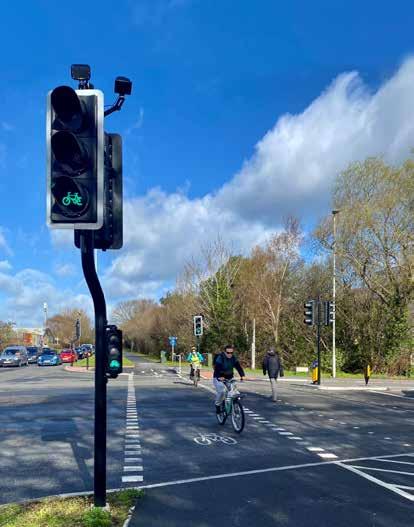

As the UK leader in intelligent transport systems, Yunex Traffic has a proven track record designing, developing, manufacturing, installing and maintaining a wide portfolio of traffic management products for customers worldwide.
Active in 24 countries, the company enables transport authorities to optimise their road networks, making them more intelligent, efficient and safer, and to deploy the latest digital technology to minimise the impact of vehicle emissions, improving the health and well-being of those living, working and studying in towns and cities.
Yunex Traffic offers a range of services - from fully integrated strategic traffic management and control suites to individual tactical solutions designed to achieve targeted benefits. These solutions not only improve traffic flow, but also enhance road safety and air quality in congested areas.
The company’s portfolio ranges from congestion charging and clean air zone solutions to electric vehicle charger supply, maintenance and warranty services, and includes urban traffic control, road safety and enforcement systems, as well as managed services and consultancy support.
Playing a key role in supporting local, regional and national transport authorities to reduce vehicle emissions and address declining air quality, Yunex Traffic increasingly works with transport authorities to deploy a range of measures, including Clean Air and Low Emissions Zones. Targeted and effective, these
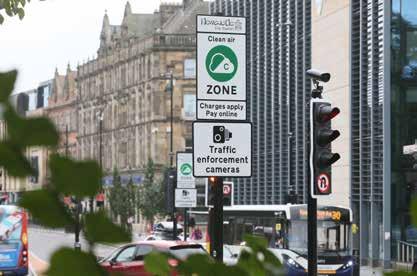
initiatives drive behavioural change and discourage the use of older, higherpolluting vehicles in towns and cities, helping to accelerate the changes required to achieve air quality improvements.
With Part 6 of the Traffic Management Act 2004 now giving all local authorities the power to enforce moving traffic offences, the company also offers a range of ANPR camerabased enforcement solutions to address contraventions at sites such as bus gateways, yellow box junctions and banned turns. These systems help transport authorities to keep their road networks running freely and efficiently, thereby reducing emissions and enhancing air quality.
Representing a new approach to the intelligent adaptive control of traffic signals, Yunex Traffic’s FUSION solution continues to demonstrate quantifiable benefits, particularly in terms of reducing congestion and improving air quality. The system ensures traffic management decisions and target outcomes are policydriven, so for example traffic signal timing can be optimized to ensure active travel modes and cleaner air outcomes are prioritised.
In partnership with Aimsun, Yunex Traffic has also developed a range of powerful new tools for local authorities. Bringing together the two companies’ respective traffic management and control and modelling software systems to create a power predictive modelling solutions, authorities are now better able to measure, model, manage and control air quality in their cities in
real time, with an effective UTMC solution providing decision support. In a similar partnership, the company is also integrating air quality monitoring data from EarthSense with its Stratos and UTC traffic management and control systems, providing traffic managers with the information and tools to proactively affect air quality in real time.
With unrivalled expertise in the delivery, installation, maintenance and operation of electrical vehicle charging infrastructure (EVCI), Yunex Traffic now maintains more than 2,000 chargers across the UK, providing manufacturers, local authorities and chargepoint operators with the necessary service support to help them achieve the 99% reliability rate required by the new Public Charge Point regulations.
The company’s own fleet also reflects its decarbonisation goals with more than 200 vehicles now electrically powered, a mix of cars, commercial vehicles and even a mobile elevated working platform (MEWP). This figure will grow to over 300 by the end of 2024 and continue to grow until the entire Yunex Traffic fleet is electric.
In recent years, the company has clearly demonstrated the vision, experience, expertise and product range to help transport authorities meet their traffic, carbon and air quality targetsincluding the need to balance transport efficiency with emissions and road safety, working closely with a broad range of customers & partners to reduce accidents, congestion and harmful emissions in our towns and cities.
We are connecting the dots of a new mobility revolution that is transforming our towns and cities.
With the broadest end-to-end portfolio of intelligent traffic management solutions, we work with cities, highway authorities and mobility
www.yunextraffic.com/uk
operators to make their road networks and fleets intelligent, enhance road safety and improve air quality.
It’s time to make the world a better place. We are ready. Are you?

We choose Quentin Willson for this issue’s Big Interview because those who heard him at our National Air Quality Conference in London last year are still talking about it. Quentin has always been passionate about cars but these days, he is particularly passionate about electric cars. When we asked if he would like to speak at the Lords’ conference he immediately accepted, saying: ‘The links to a raft of serious health conditions are well documented but still urban air quality isn’t seen a public health imperative by most politicians. EVs have a huge role to play.’
While Quentin has long been known as a motoring writer and broadcaster he has spent a good deal of time campaigning in behalf of the UK’s motorists. With Fair Charge he is campaigning on behalf of EV drivers, both present and future.
Paul Day finds out more...

Having spent your adult life working with cars, were you obsessed with them as a boy?
It occurred to me at an early age, maybe 10 or 12, that they were fabulous symbols that could change your importance in life. They could make you look younger, or more mature than you are. More prosperous, more successful. And I just gravitated towards them.
When I was 11 my dad bought me a Ford Anglia engine for my birthday, he got it from a scrapyard. I dismantled it and then got it working, much to the annoyance of the neighbour because it had no exhaust, so when you fired it up there was this huge noise. And then somebody gave me the AA Book of the Car for a birthday. So I read through that, learning what cars were all about, and how you took them to pieces and what made them work.
So by about 15 I was pretty good on cars. The teachers at school would come and court my advice. And my dad had a Vauxhall Victor, which was a desperately pedestrian car, just the most unromantic thing, and he was a university lecturer, a very, very lovely man who was a Bletchley Park code breaker but he was completely illiterate when he came to cars. I managed to strong arm him into buying a Daimler and then we were driving around in a Jag. And it was just kind of like, Whoa, this is it.
So from that moment, I determined that this was going to be my life. I realised I could buy cars and then sell them for a profit. So even before I got my license I was buying little Frogeyed Sprites for 200 quid and sell them for 350.
My mum would drive them round for me.
By the time I got to university, I'd got this little of stash of money and cars were so cheap then. So while everyone on campus was driving around in minis and escorts, there am I in a wildly unsuitable, mauve Jensen Interceptor wearing a sheepskin coat.
When I got my grant for buying books at university I bought a Granada GXL with it and pretended I was Jack Regan in the Sweeney, smoking Piccadilly cigarettes. But it was just part of this illusion that makes you a new and better person if you've got a posh car.
As a youngster, were you obsessed with the cars rather than the driving of them?
It's a mixture. It's this heady, narcotic cocktail of noise and speed and what they call vrumvrum. But I'd worked out in my tiny little mind that they were these tremendously powerful things. Your success in life was measured by the length of your bonnet. And if you look back to the 60s and 70s, it was a huge culture of bonnet badges and GXLs and GTs and all these things were absolute status symbols, they were a currency that everybody understood.
How did you ultimately get involved in the industry?
I started writing about them. This lovely man, Steve Cropley, identified me as somebody who knew about cars but could also write - particularly about second-hand cars. He
started a magazine called ‘Buying Cars’ and it got noticed. I got a call from a man at the BBC who sounded like a vicar. He said, would you come and do a screen test? And the rest, as they say is history.
When did EVs first come in to your life?
I've come from the dark side haven't I? I've spent a large part of my broadcasting career telling people to buy these large, multi-cylindered, inappropriate cars but while I was going Top Gear I was also driving electric cars, much to Clarkson's mirth.
I was one of the first journalists in the UK to drive a thing called the GMEV1, which was wonderful - the first production EV in the world. And I drove it on Sunset Boulevard and I was thinking, blimey, this is good. It was out-accelerating everything in sight, and looked cool. I said ‘this is the future and one day we might all be driving these’. GM then crushed them all because, you know, they didn't want the EV1 to interfere with their global combustion car business. And then we didn't get proper production electric cars till probably 2009.
which paid off its embedded carbon debt long, long ago.
So I decided: this technology works. We need to do something about it. And also, living in London, you just have to run your finger along the window ledge and it's black with diesel particulate. I’d walk along Marylebone Road in the traffic and get that metallic taste in the back of my throat. That’s when I decided to start this campaign called Fair Charge. And we've been campaigning for electric cars ever since.
A lot of people driving EVs they say they miss the throb and the rattle of an a combustion engine. You never found that? You were quite happy to drive along in silence?
Yeah, because if you understand about cars you realise that you're got all that friction - all that flailing around of cogs and wheels and chains and pistons and camshafts - and you understand that 70% of that power is lost by the time it gets to the rear wheels. And they breakdown so much and they cost so much to service. I had a Bentley once and I took it in for service and that's £5,000 please. And so for me, it’s a kind of liberation. My current car will do 0 to 60 in 3.1
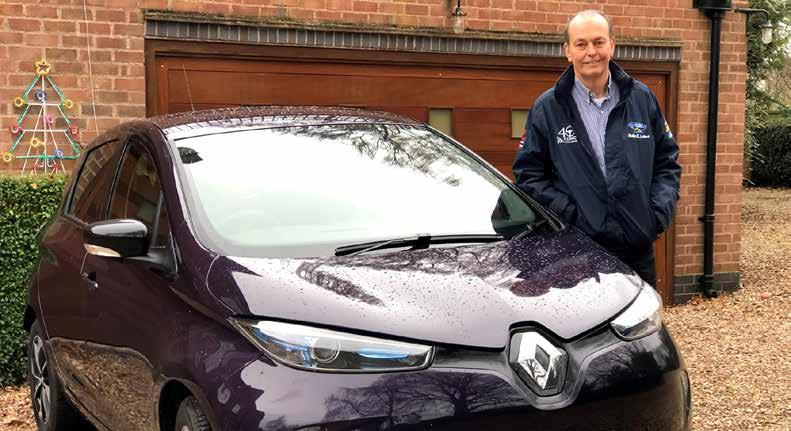
What was the first EV you owned?
The first one I bought was a ferociously expensive, miserable, hateful little car, which would only do about 50 miles on one charge. The children had to go to school in their hats and coats, freezing, ‘daddy why can’t we have the heater on?’ And the low battery warning light would come on: ‘are we going to get home? What's going to happen to us?’
As a family, we did all our motoring in these electric cars for years and years. I bought a Leaf, then a Zoe and now I've got a Tesla and it does 300 miles to one charge. The only combustion car I have now is a 60 year old Ford Mustang,

seconds, which is faster than most Ferraris. And it's quiet, it's refined, it's smooth and for me, the arch petrolhead, I don't feel that I've made any sacrifices.
When you when you step back into into a combustion car - my daughter's got a little Corsa - you just think, my goodness, this is medieval. With its funny, gear thing in the middle of the floor and the noise. So I don't miss it. And sure, I love classic cars. I drove some for a photo shoot the other day and they were great, but you come back thinking that was then and this is now. I would say we will carry on owning classic cars and driving them and getting lots of lots of enjoyment out of them. But that kind of combustion engine, that's been around for 120 years, it's had its day.
airqualitynews.com
Are you happy with where we are now in terms of transitioning the country to EVs?
Oh, don't get me started, we are so behind. With the Prime Minister's switch from 2030 to 2035, he has completely sabotaged the market. The tirade of misinformation from all the newspapers and random TV stations that EVs are terrible and they catch fire and the batteries don’t last and they make multi-storey car parts collapse and wear grooves in our roads, has disabled this whole transition.
I think that we're in at very difficult stage where all the early adopters have bought electric cars and the fleets are running around in them quite happily - we have a million electric cars on the UK roads - but getting the private buyers to make that jump is really difficult. And as the government's taken all subsidies away, there’s very little physical reason for you to change behaviour. On top of that, the price of electricity is so high. Yesterday, I went to the Treasury and presented a letter to cut the VAT on public charging from 20% to 5%.
If we're not careful, we won't have this transition and we'll go back to fossil fuels. And that's a real problem for me. So to answer your question, we need to pull our fingers out fast and I'm talking to government about this now. Otherwise, the Chinese will just sweep us away with their £15,000 EVs that can do 300 miles.
I was going to bring that up, because a lot of the car manufacturers complained when the mandate was put back five years because they were geared up to meet the original deadline. But they don't seem to be helping. They're not making cheap EVs, they're making big SUVs with electric engines and they are just too expensive.
Yes, this is what legacy auto does. They just carry on doing what they've always done and they took their big SUVs and then strapped a battery in the bottom and charged anything up to 100 grand, thinking, ‘well this is what the public wants.’ I guess they're protecting their profit margins but it's backfired on them spectacularly.
What we really need is the little £10,000, £15,000 no-frills electric car. I mean even Elon Musk, for all his staggering brilliance, has built an electric pickup truck when what he should have built was the Tesla One model - which he did talk about – for £20-£25,000. The profits are difficult on electric cars, we know that, but the cost of batteries and raw materials are coming down significantly. But everybody's missed the trick and the Chinese haven't because they know the market and there are €10,000 EVs out there.
Would you rather the Chinese were able to supply us or do you think it's more important to protect our motor industry?
It's a really, really difficult question. We should protect our domestic motor industry in the UK. There are 800,000 jobs in the supply chain and billions and billions of pounds of economic activity, but legacy auto have shot themselves in the foot. And we're so far behind we can't play catch up, we won't be able to do it, there isn't time. So do you put tariffs on electric cars from China as the Americans are doing? Which causes political friction and difficulty?
I want consumers to have cheap, affordable electric cars that are well made and go for long distances and you think, well, if they come from China, maybe we've got to have them. But we're in such a parlous position that it's very difficult.
I remember talking to the CEO of a very, very well-known car company in the UK years and years ago and said, look, you need to build an electric - well it was a big SUV - and he said ‘who would want that?’ I said I wanted one. ‘No, no, no, it's just a passing fad’. And so they went down their road of diesels and confused model strategy. And now they're blinking into the headlights of this tsunami of Chinese cars. They got it wrong.

Is there anything positive on the horizon in terms of cars?
That you're excited about, say three or four years down the line? That represents a glimmer of hope?
There's some very, very talented people in the auto industry. Really, really good although maybe there aren’t a lot of them right up at senior board level. Look at Lotus, their electric car is absolutely fantastic, really, good. Musk is fantastic. He's going to bring out a Tesla Roadster, which will do 0-60 in about one and a half seconds. And Range Rover will bring out an electric model - which perhaps might be slightly out of step with the market -but there's nothing that I'm jumping up and down about, apart from maybe the Renault 5, which is really just lovely, cheeky, aspirational, clever, retro. And that's going to be around £25,000.
I was with Sir Jim Ratcliffe the other day at INEOS, and they’ve brought out a thing called the Fuselier, which is going to have a battery and a range extender option. So that's interesting, because he realises that there is this still idea about range anxiety and that consumers want to have that backup of a hybrid or a little electric motor. So that's quite an interesting thing. And I've seen in the flesh that it looks really, really nice, but it's not going to be cheap. That's the problem.
How does the range extender work? That's not zero emission, is it?
What you've got is you've got a battery pack of, say about 40 to 50 kilowatt hours, coupled to a little… it's like

a generator which runs on petrol. If you're low on battery, that kicks in and will get you the extra distance and home. BMW pioneered that really well with the I3, and you've got the London taxis that are also running around with range extenders. There are emissions but they are nothing like the emissions from a full combustion engine. It’s like hybrids. People say no, no, no, we shouldn't have hybrids because they still pollute, but there is this consumer resistance so, in my

book, anything that improves air quality, be it a hybrid, be it a full EV, be it a range extender, be it a hydrogen car - although I'm not at all convinced about that - then we have to do it. We have to make consumers’ lives easier and make it possible for them to switch.
On the Fair Charge website, you call for more measures to help lower income drivers to be able to access EVs. Is there anything that we can do apart from reducing the VAT on public charging.
There’s a whole raft of options. We're campaigning along with the Society of Motor Manufacturers and Traders to cut the VAT on brand new EVs and second-hand EVs. That would knock 20% off the price of a used EV in some cases. Government needs to pull more levers to make this work - put signs where the electric chargers are, so people know that we've got an existing infrastructure. China's got 2.7 million electric charging points and we've got 53,000. You put your head in your hands and say, why are we so behind?
I'm going to see the new energy minister in a couple of weeks and be quite frank with her and say, look, you need to do this, because the messaging is so mixed now and that U-turn by the Prime Minister means that people are put off the idea of buying an EV until 2035. So that's, what 11 years? So no wonder the market has stumbled.
Also, the social EV is a really interesting concept. France did this thing where if you're a certain demographic and on a certain income, you can have an EV lease subsidised for €100
a month. The thing's oversubscribed. Half a million people signed up for it.
And there must be ways that we can help people without driveways, who can't charge at home, who are on lower incomes, to have electric cars and to have zero tailpipe emission. There are salary sacrifice firms like Tusker who help many 20% taxpayers: nurses and factory workers and shop workers and that's very successful. And we see when that happens that you get a 85% to 90% satisfaction rate with their electric car. We could also redeploy a lot of the secondhand cars that come off leases and from companies who are essentially dumping into a second-hand market and letting dealers buy them. Can we not repurpose those, so we can create a funded model where people on lower incomes have access to an electric car and a charging point?
Do you think anti-EV sentiment is getting worse?
It's a wedge issue and I’m afraid again, the buck stops with the government. ULEZ - and the Uxbridge by-election - was turned into a cultural issue by government and that's partly why we've got this left versus right thing. The left likes electric cars, they think they're smart, wearing polo-necks and driving Teslas. The right hates them because they want their diesel pickups and it's been really badly messaged. So you've got people learning about electric cars on Facebook, and listening to that stuff, which is being amplified again and again and again. It's nonsense.
There are people now saying that EVs are more polluting than production cars because of the particulates from the tyres. I talked to Kwik Fit about this yesterday and I said ‘Would you please tell us the party line on this? What is it?’ And he said the wear is slightly more because people tend to drive them faster but broadly, the wear patterns they see are similar to combustion cars. So, where does that come from?
I'm not a conspiracy theorist but you've got countries for whom fossil fuel is massively important and they run troll farms and things like that. And this is so huge now that it's not an accidental thing. There are newspapers who like to run these stories. The Mail did one yesterday, it was pages and pages of things that are wrong with EVs, just because Aston Martin, has not been able to produce battery that they're happy with. It’s clickbait because the advertising revenue is down and they need clicks for their reach.. so that's part of the problem.
I saw a headline this week that read ‘Stark battery warning after three cars burst into flames.’ It turns out it was people caused by people jump-starting a combustion engine car but that’s not what most of their readers would take from the headline…
Yes, that’s manipulation. There’s a headline writer being told by somebody, just do it this way and then you'll get more clicks. And for the record, let's just absolutely clear this up. Electric cars are 20 times less likely to catch fire than combustion cars. And I mean, that's a stat which is reflected in all the Scandi countries, and in America and with the Fire and Rescue Service here. So where has that thing come from?
Because of all this, all I’d say to anybody who isn't an EV convert, who’s thinking about buying one, is talk to someone who owns one! There’s a million EVs driving around in the UK and we don't hear the voices of those people, those are the voices that we're not hearing and I think it would be good if we did it.
Maybe I should do something about that.




Evotech’s year long study on classroom CO2 levels highlights the need for better ventilation in schools
Our team analysed >9.2 million sensor readings across five schools over the 2021/22 academic year.
Scan the QR code to download the full report:






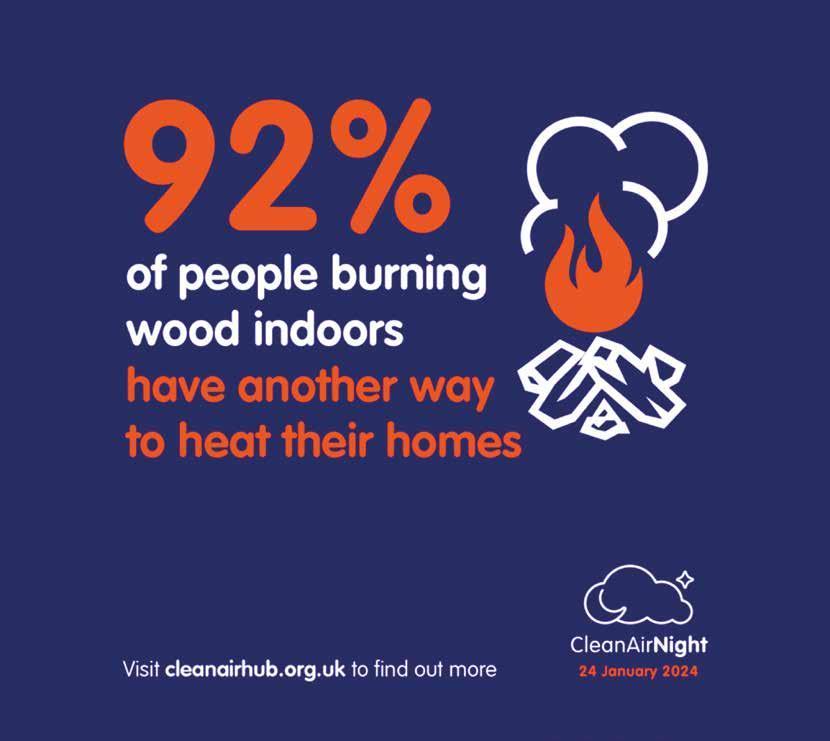
As we March on toward spring each day promises a bit more warmth. Once the sun sets, temperatures drop and many think about reaching for the log pile to set a fire to keep Jack Frost at bay and provide the cosy atmosphere or “hygge” conjured up by the thought of settling down in front of a fire. But what is the real cost of wood burning, a trend that has gripped the nation over the past decade causing domestic burning to be promoted to the undesirable position of leading source of fine particulates (PM2.5) in the UK.
The cleaner air agenda is getting more complex. The traditional Local Air Quality Management focus on outdoor pollution and more often than not road transport is moving indoors. As we typically spend more time inside buildings this seems a sensible shift.
Sources of internal air pollution have the potential to create more health impact as we spend more time indoors. With the introduction of more pollution sources we may be looking at an increasingly unhealthy indoor environment in future. There are many sources of indoor air pollution
including forever chemicals like fire retardants and VOCs from cleaning products and air fresheners. PM2.5s from solid fuel burning, or “wood burning” as the recent Clean Air Night campaign termed it, is as challenging as any.
I recently heard that 25% of PM2.5s in Birmingham were wood burning derived. Investigation into a high PM2.5 pollution episode in London found some 60% or more of particulates are a product of wood burning. These percentages are significant. With an increasing trend to burn at home, often
fuelled by the desire for “hygge” rather than necessity, reductions in pollution from other sectors could be eroded by rising domestic emissions.
And yet this source is poorly understood by the public and is not regulated like many other polluting activities where the polluter pays principal may exists. In the majority of the country, it is legal to burn wood and other solid fuels in any appliance. Only in Smoke Control Areas does the legislative machinery, and a rather clunky antiquated piece of machine at that, come into force.
Twelve months ago in Hertfordshire, we held a cleaner air seminar for councillors. We presented information to enable evidenced decision making. As a result all Hertfordshire County Council sites are now no vehicle idling areas, our countywide air

quality model has been interrogated to understand how the county fairs in future should the Clean Air (Human Rights) Bill move forward, and the first ever Clean Air Night has taken place shining a light on the uncomfortable truth about wood burning.
After hearing evidence around domestic burning a healthy debate took place here in Hertfordshire between officers and councillors. The outcome was a desire to take a leading role in promoting awareness about the impacts of wood burning to our population enabling residents to make informed decisions. A need to acknowledge differences between rural and urban areas and sensitivity in a cost of living crisis was noted - the key public health message of keeping warm in winter must prevail.
We had previously raised our interest with Global Action Plan (GAP), creators of Clean Air Day, and the idea of a sister campaign to promote messages had been considered. The chance to harness the experience and existing networks that
GAP had to offer was a clear plus to any future partnership. And so Clean Air Night (CAN) started to take shape. Importantly wider local authority interest existed with the Surrey Air Alliance and Lancaster City Council also championing action. Knowing we were not a lone local authority voice was crucial and created some hygge of our own.
It was agreed that the first CAN should not be a behavioural change campaign. People need awareness and understanding before considering making a change and public knowledge was known to be low. Instead, dispelling myths around wood burning seemed to fit the narrative we wanted to create. Myths that wood burning is cheaper than using alternative heating systems, is environmentally friendly/ carbon neutral and is not a major source of air pollution were picked as key message areas. Overall, we wanted to highlight that wood burning harms everyone’s health.
Crucial to the campaign success was validation of messaging by authoritative voices. Experts in the field were engaged aligning to each myth and detailed reports were drawn on to provide the evidence base. What followed was a four week campaign to deliver messages over the winter period finishing with a summit event. The messaging was made available to all promoting consistency over the widest possible area. The summit gave a platform for those involved to highlight their thinking and allowed experts to showcase the evidence base. For example, Dr Gary Fuller highlighted the societal health cost of every burning home in London was £800. With over 1000 installations of burning appliances in Hertfordshire in 2023 alone the cost quickly mounts up.
Post campaign we can start to reflect and evaluate. The campaign received 42 official supporters including the CIEH, Association of Directors of Public Health and NHS trusts. 21% of local authorities shared assets over the campaign lifetime. Over 500 million social media impressions were created prompting over 100,000 views of the Clean Air Hub, a GAP resource. Over 130 people attended the summit. Printed press ran articles including an exclusive to The Times and BBC attention.
In Hertfordshire we promoted organic social media messages and invested in paid for social media. The importance of paid media was a
take home from a previous campaign, Let’s Clear the Air, which found they generated more reach and engagement. A local radio advert was created to ensure a mixed media approach. The process enabled us to raise the agenda with senior officers including our Director of Public Health who took up the mantel releasing quotes for press and a video message for the summit event.

Evaluation has found 28% awareness of the campaign after its first year which exceeded expectation. Thanks goes out to all those who have taken part in all stages of the campaign to ensure campaign success including withstanding abrasive efforts from those with vested interests, testament to the rigorous evidence base messages were founded on.
Now the conversation has been started in the public domain I hope others feel able to support future year efforts. By continuing the dialogue and raising awareness we can have an impact on health, climate change and global natural systems creating a cleaner, greener and healthier futuresomething that can created that hygge feeling for us all.

For more information visit: https://www.actionforcleanair.org.uk/ campaigns/clean-air-night to read the facts and evidence base behind the campaign.
Journalist Emily Whitehouse speaks to sciencebased climate litigator, Dr Andrew Boswell, about efforts to bring a legal challenge against the government in a bid to put the brakes on a project that he claims will have severe environmental implications.
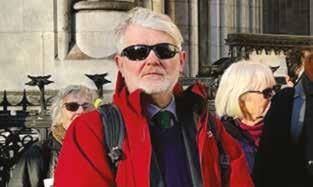
Most people from the air quality sphere who spend any time on X (Twitter) will have come across Dr Andrew Boswell in their timeline, even if they don’t actively follow Norwich’s most determined air quality campaigner.
In 2022, Dr Boswell, a former member of Norwich City Council’s Green Party, embarked on his first legal case as he challenged plans to create three new road schemes. National Highways were looking to construct two new dual carriageways, two new junctions and redevelop the Thickthorn junction to the south of Norwich, where the A11 meets the A47, at an estimated cost of around £500m.
When the proposals for the projects were submitted, the government calculated the carbon emissions from each scheme individually, however, Dr Boswell identified a flaw in the maths, claiming that the government have failed to consider that the overall carbon emissions of the simultaneous projects amount to more than the sum of their parts.
‘I’ve been really interested in climate change at this sort of technical level for around 20-odd years,’ he explains, ‘but I have only just embarked on my first legal case which has now been ongoing for three years. I was previously a member of the Green Party but retired in 2017 after 12 years. Norwich City Council are notorious for granting various road schemes which cause serious harm to the environment, and I believed I could make more of a change from the outside,’ Dr Boswell says.
‘When getting involved with this case I examined the plans which were proposed by the government rather than the local council. Large road schemes often go through a DCO – otherwise known as development consent order – which is where government planning inspectors are brought in to examine a proposal. This can take around six months. In some

circumstances there can be hearings, but it’s largely done on paper,’ Dr Boswell explains. ‘The overall decision on whether to give the plans the greenlight is made by the Secretary of State for Transport.’
He continues: ‘My argument for the case is that National Highways should have looked at the impact that all three of the proposed road schemes will have on the environment. Despite being separate schemes, they will all be happening at the same time and in close proximity. Transport and construction are two of the biggest contributors to poor air quality levels in the UK, however instead of addressing this, the government seem to be looking for ways to bend the rules.’
Although the three road plans were given the go-ahead in 2022, they were put on hold towards the end of that year when a judge gave Dr Boswell leave to launch his action. The campaigner set up a crowdfunding campaign through the CrowdJustice platform, where he received 1,500 donations that would help take his case to court. However, despite receiving a significant amount of support, in May 2023 the High Court upheld the decision to approve the three road schemes.
‘Last year the courts sided with the government, but after re-conferring with my lawyers in November 2023 my determination to see carbon emissions properly assessed on road schemes was vindicated. My lawyers said they thought my case was strong enough to take to the Court of Appeal, which only happens if you have a decent argument. You can’t just appeal a case simply because you’ve lost in the High Court,’ Dr Boswell explains.
As a result, on 16th January 2024, Dr Andrew Boswell attended the Court of Appeal in London for his hearing. In contrast to his experience at the High Court, he arrived with hundreds of environmental campaigners who took part in a
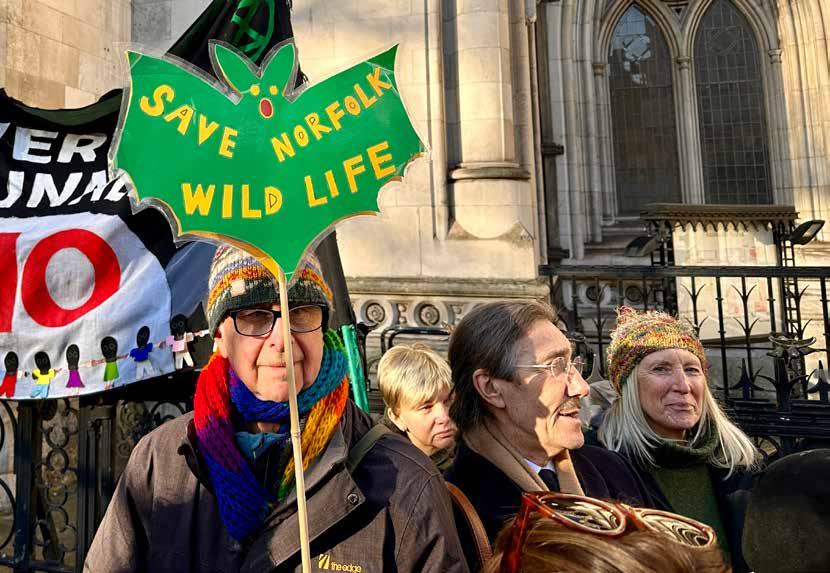
staged protest outside of the court an hour before the case began.
The significance of this case was that, should it be found in Boswell’s favour, it could trigger a series of cases already prepared by campaigners across the country. This includes an appeal by the Campaign to Protect Rural England (CPRE) against trans-Pennine A57 link roads scheme, which was proposed to improve journeys between Manchester and Sheffield. The CPRE said the scheme would carve a swath through the Peak district, needlessly damaging green belts around both cities.
At the Court of Appeal, Dr Boswell’s barrister David Wolfe, from Kings Counsel, laid bare that a relatively small section of the UK’s highway network around Norwich would contribute almost 0.5% of the UK’s entire carbon budget between 2033 and 2037, ultimately hindering plans to reach net zero goals.
Dr Boswell says: ‘Although I can’t talk about too much that was said in court, I can confirm that the argument we put forward felt stronger than our case at the High Court. I think the government’s case was weaker and we were able to close off more of their arguments.’
Dr Boswell adds: ‘None of this would have been possible without the tremendous support from the public. When our case eventually reached the Court of Appeal, the number of people who had donated to the Crowdfunding was just shy of 2,000 and we had managed to raise £70,000. In addition to this funding campaign, we also hosted local fundraisers - which included storytelling events and fun runs - to raise legal funds.
‘The support mirrors a case that was presented in Holland on climate mitigation in 2015. Around 900 people took part in taking the Dutch government to court for failing to protect citizens from climate change. I know 900 people can’t be involved in a court case in the UK, but the help I have received
from other environmentalists has made it feel like I’ve had an army cheering me on the entire way. I’m overwhelmed by how many people have felt confident enough to voice their opinions. It’s really amazing.’
In spite of these efforts, on Thursday 21st February 2024, Court of Appeal judges ruled in favour of the Department for Transport, meaning National Highways were granted development consent orders to start work on the A47 projects.
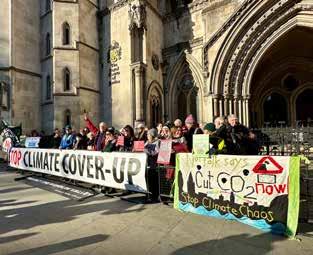
Less deterred than you might think, Dr Boswell is now considering taking his case to the Supreme Court, believing that the number of people who have backed his inquiry, both in person and online, have proven that it is ‘a case of national interest.’
It seems this might not yet be the end.






